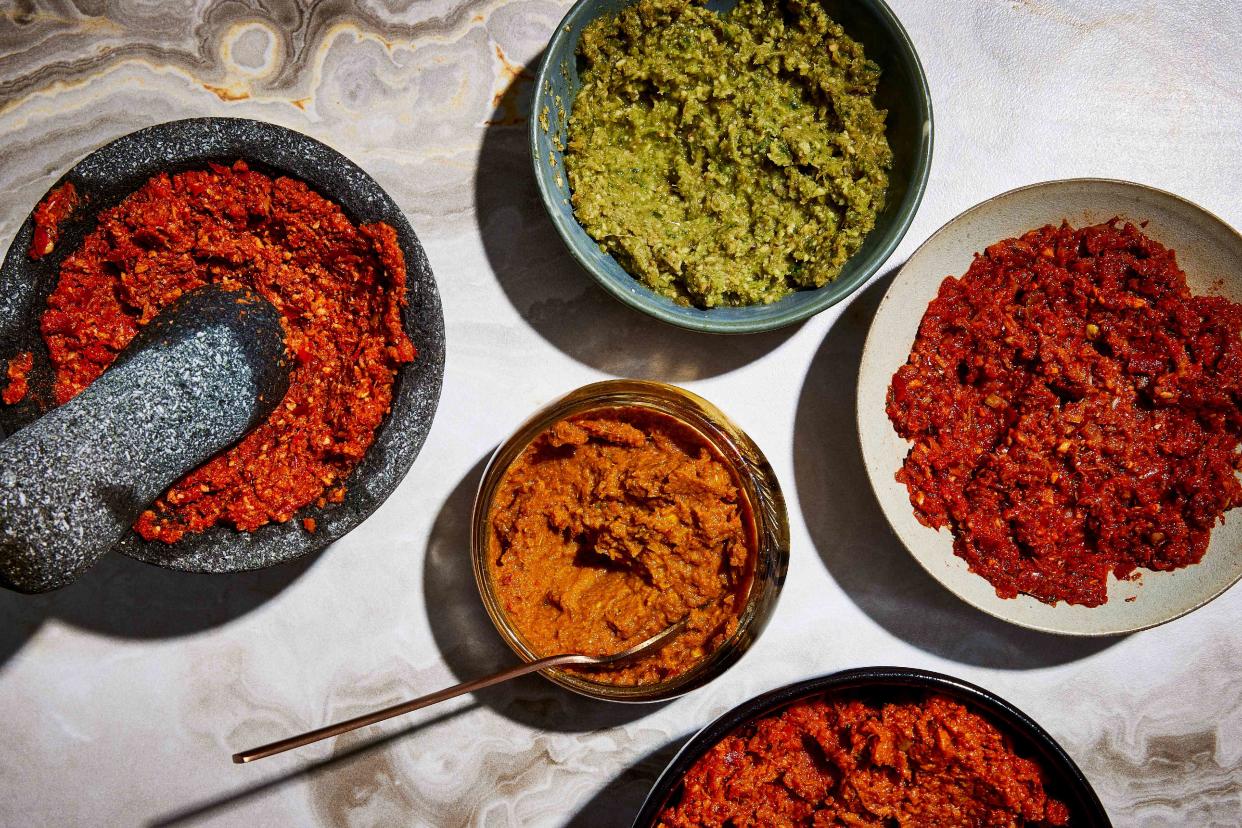5 Ways My Grandma and I Love To Use Thai Curry Paste in Our Cooking
Thai curry pastes are foundational ingredients in Thai cooking that can be used for much more than making curries.

Jennifer Causey / Food Styling by Emily Nabors Hall / Prop Styling by Christina Daley
Whenever I see my grandma, we make a large batch of curry paste. It’s one of the most meaningful family rituals I have. And though we savor every bit of curry we make from it, after a few days, there’s always a mound of curry paste left, and we’re left wondering what to do with it. It’s a good problem to have — that surplus of curry paste that is akin to pure gold. If you find yourself in a similar predicament, follow our lead and get creative with it.
What is Thai curry paste?
As a staple in Thai cuisine, curry paste is a flavor-packed essential for cooking made from ingredients like shallots, chilies, garlic, galangal, and cumin. It is widely known and loved as the base for countless Thai curries, but also does double duty as an extremely versatile condiment and ingredient in Thai cuisine, where it might be used in a marinade or a stir-fry. There are many different types of Thai curry pastes, each with their own unique blend of aromatics and herbs, and any of them can be used in a variety of dishes. Here are some of our favorite ways to use Thai curry paste.
Make a curry
The most universal way to use Thai curry paste is to make a curry. With homemade or store-bought Thai curry paste (my family swears by Maesri brand), the first step in using the paste in a curry is to heat about one to two tablespoons of oil with about two tablespoons of curry paste. Now, making curry is a personal journey, so it's important to note that the amount of paste you use depends on your taste and the amount of curry you're making. You'll get a deeper, spicier flavor by using more paste, whereas a milder one is achieved with less.
Related: The Story of Thai Curry, According to a Chef and a Lifelong Fan
After the paste is stir-fried for one to two minutes, add your choice of protein and vegetables and stir-fry until they are fully cooked. After adding coconut milk, simmer the curry until it reaches your preferred consistency. A good rule of thumb for using coconut milk is to use roughly one cup of coconut milk per tablespoon of paste; taste and adjust the amounts from there. After the coconut milk has simmered for a few minutes, garnish your curry with fresh cilantro and sliced chilies if desired, and serve over rice or noodles. This basic approach yields all different kinds of curries, depending on which curry paste you start with and what proteins and vegetables you use. Some of my favorites include Massaman Curry, Thai Red Curry, Green Curry, and Yellow Curry.
Use it as a marinade or rub
Thai curry paste can also be used as a marinade for grilled or roasted meats. Curry paste lends a bright and tasty tang to recipes like Thai Curry Paste Pulled Pork Sandwiches, Grilled Red Curry Chicken, and Green Curry Beef Skewers with Fried Basil Oil. Simply mix the curry paste with a little oil and brush it onto the meat and let it sit before cooking. The paste will add flavor and help to tenderize the meat as it cooks. The same goes for rubs: Thai curry pastes can be mixed with a little oil and used as a rub for grilled or roasted meats to both add flavor and to tenderize them.
Add it to soups
Thai curry paste can be used to add depth and flavor to soups by mixing the paste with broth and adding your choice of vegetables and protein. As seen in this recipe for Pumpkin Soup with Thai Red Curry Paste and Lemongrass, the broth gets a tasty kick from the addition of red curry paste.
Add it to stir-fries
We most commonly use red curry paste for this method because its base is the most versatile in Thai cooking canon, but most all curry pastes will lend a powerful and palatable punch to an array of stir-fries. To do this, mix the paste with a little oil and stir-fry your choice of protein and vegetables until they are cooked through, then add your other stir-fry ingredients like vegetables, rice, or noodles.
Related: The Best Way to Stir-Fry, According to a 'Wok Therapist'
Stir it into a dip
My grandma hasn’t quite caught on to this idea yet, but it’s become a fun party trick for my friends and me. I love mixing some Thai curry paste with a bit of thick coconut cream or yogurt to make a dip for parties or a meal. I start out small, with about a tablespoon of paste per cup, and add more as needed. Then I serve it with vegetables, crackers, or bread as an easy appetizer.
For more Food & Wine news, make sure to sign up for our newsletter!
Read the original article on Food & Wine.







